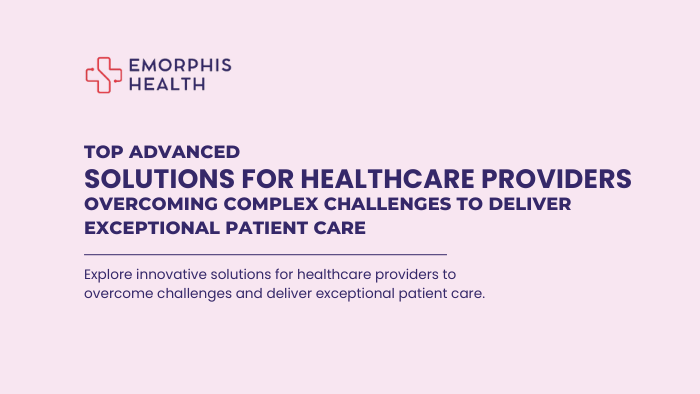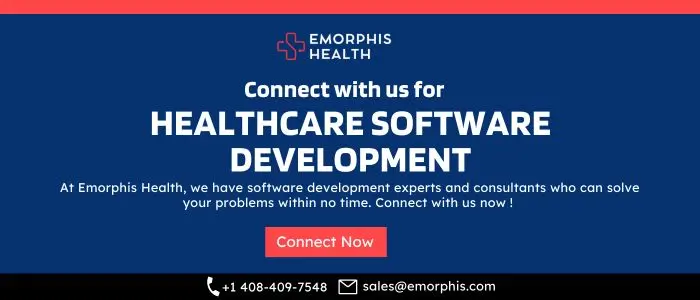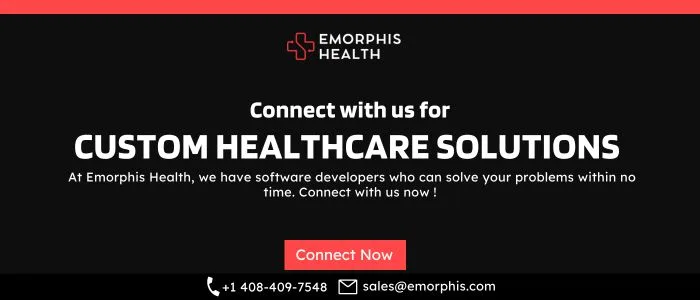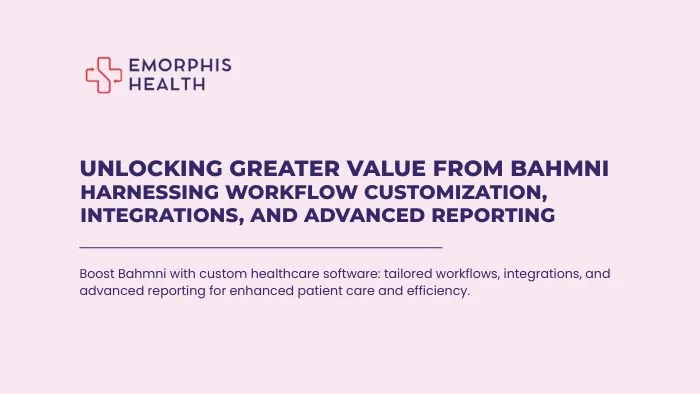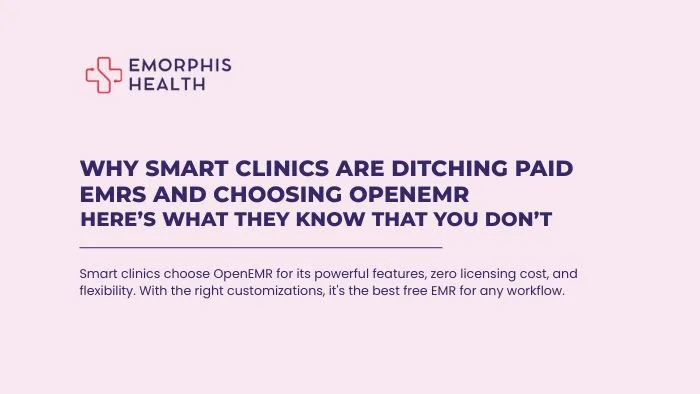Today, healthcare providers encounter a myriad of challenges that hinder their ability to deliver optimal care. From navigating complex administrative tasks to, in fact, grappling with information overload, doctors often find themselves contending with various pain points that detract from their primary focus, patient well-being. This article talks about how technology can help healthcare providers with their work. It’s important because it shows how digital healthcare tools can make doctors’ jobs easier and improve patient care. Moreover, by explaining the problems healthcare providers face and how technology can solve them, this article aims to encourage discussions and teamwork to make healthcare better for everyone.
Top 10 Healthcare Providers’ Challenges and Its Solutions for Patient Care
See Contents
Let’s delve into these pain points now, in fact, it is crucial to understand the complexities that physicians, healthcare providers, or doctors face daily. Here are the common pain points and also find there technological solutions for better patient care.
1. Administrative Burden
Doctors are weighed down by many administrative tasks, ranging from documentation to, in fact, billing, and scheduling. These responsibilities consume significant time, diverting focus away from patient care. The administrative burden not only drains energy but also contributes to inefficiency during patient encounters. To tackle the administrative burden, innovative EHR systems automate tasks, freeing up time for doctors to focus on patient care.
Electronic Health Record (EHR) systems, such as Epic and Cerner, stand as pillars of efficiency in healthcare administration. These comprehensive platforms automate documentation, billing, and scheduling tasks, liberating physicians from the burdensome constraints of manual paperwork and allowing them to allocate their time more judiciously toward patient care.
2. EHR (Electronic Health Record) Usability
The integration of Electronic Health Record (EHR) systems, while intended to streamline processes, often adds to the complexity of doctors’ workflows. Many physicians find these systems cumbersome and time-consuming to navigate, leading to frustration and reduced efficiency. The usability issues associated with EHRs pose significant challenges to seamless healthcare delivery.
The advent of user-friendly EHR systems marks a pivotal advancement in healthcare technology. Platforms engineered for intuitive navigation and tailored functionality, such as Epic’s Hyperspace and also Cerner’s PowerChart, streamline workflows and enhance productivity. In fact, by prioritizing ease of use and customization, these solutions mitigate frustration among physicians and optimize the utilization of electronic health records in clinical practice.
3. Information Overload
In the rapidly evolving field of medicine, doctors are inundated with vast amounts of medical information. Staying updated with the latest research findings and guidelines becomes a daunting task, adding to the already demanding nature of their profession. The constant influx of information contributes to the overwhelming pressure faced by physicians. Moreover, as a solution to information overload, AI-driven diagnostic tools offer actionable insights, empowering physicians to make informed decisions and improve patient outcomes.
Clinical decision support systems, exemplified by UpToDate and VisualDx, represent the pinnacle of information management in healthcare. These sophisticated platforms leverage artificial intelligence and machine learning algorithms to synthesize vast volumes of medical literature and provide clinicians with real-time access to evidence-based resources. By facilitating informed decision-making and reducing cognitive load, these applications empower physicians to deliver care grounded in the latest research and guidelines.
4. Communication Barriers
Effective communication is paramount in healthcare, yet breakdowns between healthcare providers, patients, and other stakeholders are commonplace. These communication barriers can result in errors, inefficiencies, and delays in care delivery. Bridging these gaps requires concerted efforts to facilitate seamless information exchange and collaboration among healthcare teams. Furthermore, to address communication barriers, telemedicine platforms facilitate seamless interactions between healthcare providers and patients, enhancing care coordination and accessibility.
Telemedicine platforms, exemplified by Zoom for Healthcare and Doxy.me, serve as conduits for seamless communication and collaboration in the modern healthcare landscape. These secure, HIPAA-compliant solutions facilitate virtual consultations and enable remote patient monitoring, transcending geographical barriers and fostering continuity of care. By promoting effective communication between healthcare providers and patients, telemedicine platforms enhance care coordination and improve patient outcomes.
5. Clinical Decision-Making Complexity
Doctors encounter complex medical cases and diagnostic challenges regularly, necessitating quick and accurate decision-making under pressure. The complexity of these cases, coupled with the volume of data to consider, adds another layer of difficulty to physicians’ responsibilities. Negotiating these challenges requires access to reliable tools and resources to support clinical decision-making. Moreover, addressing patient safety concerns, clinical decision support tools enhance diagnostic accuracy and mitigate the risk of medical errors, safeguarding patient well-being.
Artificial intelligence-driven diagnostic platforms, such as IBM Watson Health and VisualDx, epitomize the convergence of technology and clinical expertise. These cutting-edge tools leverage machine learning algorithms to analyze patient data and medical literature, offering clinicians actionable insights and diagnostic recommendations. By augmenting clinical judgment and enhancing diagnostic accuracy, these platforms empower physicians to navigate complex medical cases with confidence and precision.
6. Patient Engagement and Adherence
Encouraging patients to actively participate in their healthcare and adhere to treatment plans poses a significant challenge for doctors. Lack of patient engagement can impact health outcomes and hinder the effectiveness of care delivery. Addressing this challenge requires innovative strategies to promote patient empowerment and foster collaborative relationships between doctors and patients. Moreover, to promote patient empowerment, mobile health applications offer tools for self-management, encouraging active participation in healthcare and adherence to treatment plans.
Mobile health applications, exemplified by MyChart and Healthie, catalyze patient engagement and promote adherence to treatment plans. These patient-centric solutions facilitate remote access to medical records, enable secure communication with healthcare providers, and empower individuals to take an active role in managing their health. By fostering patient empowerment and facilitating continuous communication, these applications enhance patient satisfaction and promote positive health outcomes.
Check more details on Healthcare App Development
7. Burnout
The demanding nature of the healthcare profession often leads to burnout among doctors. Long hours, on-call duties, and high-stress levels contribute to physical and emotional exhaustion, negatively impacting both personal well-being and professional performance. Burnout not only affects individual doctors but also undermines the quality of patient care. Additionally, to combat burnout, telemedicine platforms enable flexible work arrangements, reducing stress and promoting physician well-being while ensuring continuous patient care.
Telemedicine platforms, such as Amwell and Teladoc, offer a paradigm shift in physician work-life balance and well-being. These platforms facilitate virtual consultations, enabling physicians to deliver care remotely and alleviate the strain of long commutes and on-call duties. By promoting flexibility and reducing occupational stress, telemedicine platforms safeguard physician well-being and mitigate the risk of burnout.
8. Accessing Specialized Medical Care
Patients residing in rural or underserved regions encounter obstacles when trying to reach specialized healthcare services, primarily due to geographical limitations. Disparities in healthcare access and outcomes persist, particularly among marginalized communities. Addressing these disparities requires innovative approaches to extend the reach of healthcare services and ensure equitable access to quality care. In response to disparities in access to specialized care, telehealth initiatives bridge geographical gaps, providing all patients with equitable access to expert medical services.
Telehealth initiatives, such as Project ECHO and Doximity Dialer, democratize access to specialized medical expertise. These innovative programs connect healthcare professionals in underserved areas with specialists through virtual consultations, facilitating knowledge sharing and enhancing clinical decision-making. By bridging geographical disparities and promoting collaborative care, telehealth initiatives ensure equitable access to specialized services for all patients.
9. Healthcare Disparities
Disparities in healthcare access and outcomes based on factors such as race, ethnicity, socioeconomic status, and geography remain significant challenges. These disparities undermine efforts to achieve health equity and exacerbate existing inequalities in healthcare delivery. Closing these gaps requires concerted efforts to address systemic barriers and promote inclusive healthcare policies.
Telemedicine solutions, exemplified by HealthTap and 98point6, serve as catalysts for healthcare equity and inclusivity. These virtual care platforms offer on-demand consultations, transcending barriers of geography and socioeconomic status to provide accessible healthcare services. By democratizing healthcare access and promoting culturally sensitive care, telemedicine solutions play a pivotal role in addressing healthcare disparities and fostering health equity.
10. Medical Errors and Patient Safety
Preventable medical errors and adverse events pose serious risks to patients and healthcare providers alike. These errors can have devastating consequences, eroding trust in the healthcare system and compromising patient safety. Addressing this challenge requires a multifaceted approach that prioritizes patient safety and quality improvement initiatives.
Clinical decision support tools, such as MDCalc and Isabel, augment diagnostic accuracy and mitigate the risk of medical errors. These sophisticated applications offer diagnostic assistance, medication alerts, and evidence-based recommendations, serving as invaluable aids in clinical practice. By enhancing patient safety and promoting adherence to best practices, clinical decision support tools uphold the highest standards of care and contribute to improved patient outcomes.
By acknowledging and addressing these pain points, we can pave the way for a healthcare system that better supports the needs of both doctors and patients. It’s essential to recognize the complexities inherent in healthcare delivery and work collaboratively to implement solutions that enhance efficiency, effectiveness, also, equity in healthcare. Moreover, embracing these technological advancements empowers healthcare professionals to overcome the challenges inherent in modern healthcare delivery. From streamlining administrative processes to enhancing clinical decision-making, technology serves as a catalyst for optimization and innovation in patient care. As we continue to leverage these cutting-edge solutions, the future of healthcare promises unparalleled efficiency, efficacy, and excellence.
Benefits of Technological Solutions in Healthcare
technological advancements stand as key drivers of transformative change, ushering in a new era of efficiency, effectiveness, and excellence in patient care. These innovative solutions offer unparalleled benefits to both healthcare providers and patients alike, reshaping the way healthcare is delivered and experienced. Let’s delve into the various benefits of technological solutions in healthcare and also, explore how they are revolutionizing the future of medicine.
a. Efficiency Enhancement
Technology streamlines administrative tasks, liberating healthcare professionals from the burdensome constraints of manual paperwork and allowing them to dedicate more time to what truly matters – patient care. By automating documentation, billing, and scheduling processes, advanced systems enable doctors to optimize their workflows and deliver care more efficiently.
b. Improved Patient Care
Advanced Electronic Health Record (EHR) systems serve as powerful tools for enhancing patient care. By facilitating better documentation, coordination, and communication among healthcare teams, these systems ensure that patients receive comprehensive and coordinated care. Improved access to patient information enables healthcare providers to make more informed decisions, leading to better health outcomes and overall patient satisfaction.
c. Streamlined Communication
Telemedicine platforms bridge the gap between healthcare providers and patients, fostering seamless communication and improving care coordination. Through virtual consultations, secure messaging, and remote monitoring capabilities, telemedicine enhances accessibility to healthcare services, particularly for individuals in remote or underserved areas. By facilitating timely and convenient communication, these platforms promote continuity of care and patient engagement.
d. Enhanced Clinical Decision-Making
Artificial intelligence-driven diagnostic tools leverage cutting-edge algorithms to analyze vast amounts of patient data and medical literature, offering valuable insights and recommendations to healthcare providers. By augmenting clinical judgment and improving diagnostic accuracy, these tools empower physicians to make more confident and informed decisions, ultimately leading to better patient outcomes and treatment efficacy.
e. Patient Empowerment
Mobile health applications empower patients to actively participate in their healthcare journey. Through features such as medication reminders, symptom tracking, and access to educational resources, these applications enable individuals to take a proactive role in managing their health conditions. By promoting self-management and adherence to treatment plans, mobile health apps contribute to improved health outcomes and patient satisfaction.
f. Work-Life Balance
Telemedicine platforms offer flexible work arrangements for healthcare professionals, allowing them to deliver care remotely and reduce the strain of long commutes and on-call duties. By promoting work-life balance and reducing occupational stress, telemedicine platforms support physician well-being and job satisfaction, ultimately benefiting both healthcare providers and their patients.
g. Access to Specialized Care
Telehealth initiatives break down geographical barriers, ensuring equitable access to specialized medical expertise for patients regardless of their location. Through virtual consultations and telemedicine services, individuals in remote or underserved areas can receive timely and expert care moreover, which leads to improved health outcomes and reduced healthcare disparities.
h. Healthcare Equity
Telemedicine solutions promote inclusivity and culturally sensitive care by offering language interpretation services, culturally tailored resources, and virtual care options. By addressing disparities in healthcare access and outcomes, telemedicine contributes to the advancement of healthcare equity and the provision of high-quality care for all patients, regardless of their background or circumstances.
i. Patient Safety
Clinical decision support tools provide invaluable assistance to healthcare providers by flagging potential medication errors, alerting to drug interactions, and offering evidence-based recommendations. By mitigating the risk of medical errors and adverse events, these tools safeguard patient safety and uphold the highest standards of care delivery.
j. Innovation and Excellence
Overall, technological solutions drive innovation and excellence in healthcare delivery, promising a future characterized by improved efficiency, efficacy, and patient-centered care. By harnessing the power of technology, healthcare providers can also, continue to push the boundaries of what is possible in patient care, ultimately transforming lives and shaping the future of medicine.
Technological solutions in healthcare have the potential to revolutionize the way care is delivered, experienced, and moreover perceived. From enhancing efficiency and communication to improving clinical decision-making and patient empowerment, moreover, these innovations offer tangible benefits that extend far beyond the confines of traditional healthcare settings. By embracing technology and fostering a culture of innovation, healthcare providers can pave the way for a brighter, healthier future for all.
Further recommend reading more details on Patient Engagement Solutions, and how technology is empowering patients.
Conclusion – Technology’s Role in Healthcare Transformation
Technology stands as a beacon of hope, moreover, offering transformative solutions to age-old challenges in healthcare. From streamlining administrative tasks to improving patient care and access, technological advancements also promise a future defined by efficiency, effectiveness, and equity. By embracing these innovations, we also pave the way for a healthcare system that is not only resilient and responsive but also compassionate and patient-centered. Together, let us chart a course toward a brighter future where technology and humanity intersect to shape a healthcare landscape that leaves no one behind.
Emorphis Health, with its cutting-edge technology and also, unwavering commitment to healthcare innovation, stands poised to lead the charge toward a brighter future in healthcare. Moreover, through our comprehensive suite of solutions, including advanced healthcare software development, app development, and emerging technologies like AI-driven solutions, we, in fact, look to empower healthcare providers to overcome challenges and deliver exceptional care to patients. By leveraging our expertise in software development and healthcare technology, we also enable seamless communication, streamline workflows, and enhance clinical decision-making. Together, let us embark on a journey towards a future where technology transforms healthcare delivery and also improves the lives of patients and providers alike.
Read more details on Enhancing Patient Satisfaction in Healthcare.

